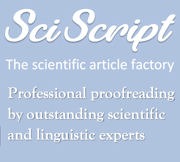|
Information for Manuscript PreparationThe following guideline contains information on how you should prepare your manuscript considered for publication in the RDS. For a printable version of this manual use the 'print page' link in the footer of this page or download the PDF version.
General:
All submitted manuscripts must be written in English (US style) and should be typed on paper of standard size, text preferably adjusted at 10 to 12 points and with margins of at least 2.5 centimeters on all sides. The material should be double-spaced, including captions, legends, references, and so forth. Pages must be numbered. Printed submissions should contain high-quality reproductions. Online submissions (closed) should be generated in one of the following file formats: Word, PDF, Tex, RTF. The text should be checked carefully to minimize changes in proofs. If your manuscript is accepted for publication then a proof will be sent out to the corresponding author. The RDS does not assume responsibility for orthographic errors after proofs are returned from the author(s) or if proofs do not return within a reasonable period of time. When you return the proof, an electronic version (an attachment to an e-mail or on floppy disc or CD if sent by post) of the corrected manuscript must be sent along with the proof if not sent along with the initial submission.
Title page:
The title page should contain the following elements in the following order:
Title of the paper. The title should not have subtitles or non-standard abbreviations and should not exceed 20 words.
Author(s) names with full first and last names (without qualifications).
Affiliations of all authors and institutions/addresses where work was performed.
E-mail address and phone number of at least one author to whom correspondence and reprint requests are to be addressed.
Information on institutional or corporate funding sources and acknowledgments of any kind.
Abstract page:
The abstract page should contain a maximum of 10 Medline keywords and the abstract of the paper. The author(s) should write the abstract as a short and separate essay conveying the main objectives, methods, results and conclusions of the paper in order to allow the general readership to gain insight at a glance and to follow easily. The abstract should have not more than 250 words. Please, avoid the use of abbreviations and references in the abstract if possible. If you prefer to use abbreviations, spell out expressions completely (even if they are considered to be standard) and indicate the respective abbreviations in parentheses when you use them for the first time. Thereafter you may use the abbreviation throughout the article.
Length of Manuscripts:
Original full-length research manuscripts (such as clinical trials, laboratory research, etc.). The pure text without abstract, figures, tables, references and legends should not contain more than 7500 words. References, tables, figures and legends are without restrictions. However, authors are asked to restrict the number of references to those essentially necessary for citations and further reading. Illustrations should be used for the reader's benefit to assist understanding of the paper's main statements and results.
Shorter papers of original work may have about 3500 words, thirty references and two tables and figures.
Review articles: A maximum of 9000 words should not be exceeded. References maximum 150. Topics should be arranged with the editors. Please refer to Info (at) Soc-BDR.org.
Articles in column "Diabetic Perspectives" may have approximately 5000 words, two tables, two figures, and fifty references.
Comments: Maximum of 2500 words, two tables or figures, 20 references.
Letters to the editors: Not more than 2500 words, two illustrations, 20 references.
Case reports may have about 3500 words, two illustration and twenty references.
Reports on conferences, lectures, workshops may also have approximately 3500 words, two tables or figures and fifty references. The permissions of the cited authors must be available. A corresponding annotation must be submitted along with the report if their work is still unpublished.
Abbreviations:
Authors should only use standard abbreviations without further definitions within the text (not the abstract). See paragraph 'Abstract page' for further information on the use of abbreviations within abstracts. Abbreviations for expressions and units are considered to be standard if they are consistent with the RDS' approved list, available here. Non-standard abbreviations must be written out in the text passage where used for the first time. After first use, non-standard abbreviations may be used throughout the text. Unit names should be abbreviated only in combination with numbers.
Footnotes:
Footnotes should not appear in the text. They are only accepted on the frontpage for the authors affiliation information and within tables. Use numbers for the assignment of affiliations to authors and letters for tables.
Figures and Tables:
Please provide figures and tables on separate sheets. The preferred positions of any figures and tables should be indicated in the text. Figures and tables should also be indicated by Arabic numerals in the legend below the items and when cited in the text starting with '1' for each category (e.g. Table 1, Table 2, Figure 1 etc.). Each item should be featured with a short title in the legend. Tables should be self-explanatory and should only contain the (short) title in the legends. Figures may be featured with an explanatory text in the legends. A maximum of 250 words should not be exceeded for each legend. Figures must not be larger than 17.2 x 21.5 cm (width x height). They may be black and white, or color. However, decorative coloring and boxes around the figures should be avoided. Figures should be provided as separate files in EPS, TIF, BMP or JPG format (preferably 300 dpi) when the paper has been accepted for publication at the latest.
References:
Refer to citations or indications of foreign sources (such as articles, books, letters or conference reports) by sequential numbers in square brackets within the text. Provide a list of all references you use in the text on a separate sheet. The references should be ordered as they appear in the text, using Arabic numerals. Type author names in bold letters followed only by the initials of first names. Restrict the number of author names to ten and use 'et al.' after the tenth name. Use abbreviations for indexed journals corresponding to PubMed (click here to enter the PubMed webpage containing a database of title abbreviations. You may want to download the PubMed zip-file from this page). You may also refer to the PDF version List of Journals Indexed in Index Medicus available from the Superintendent of Documents, U.S. Government Printing Office, Washington, D.C. 20402, U.S.A., DHEW Publication No. (NIH) 80-267; ISSN 0093-3821. Titles of unlisted journals should be written out fully. Arrange your references in the following formats: Journal articles:
| 1. | Banerjee M, Bhonde RR. Islet generation from intra islet precursor cells of diabetic pancreas: In vitro studies depicting in vivo differentiation. JOP 2003. 4(4):137-145. |
You may use the Reference Manager file available here or the Endnote file available herefor import of your references in RDS format.
For articles in press, substitute indications for volume and pages by 'In press.' The same applies to discussion articles, working papers and abstracts (substitute 'Discussion article', 'Working paper' or 'Abstract'). Unpublished work, personal communications etc. should appear in the text where used but not in the references. Arrange your other references as follows: Books:
| 2. | Weibel ER. Stereological methods. Practical methods for biological morphometry. Academic Press 1979. Chapter 4, pp 101-169. |
Articles in books:
| 3. | Pictet R, Rutter WJ. Development of the endocrine pancreas. In: Steiner DF, Frenkel N. Handbook of physiology. American Physiological Society 1972. Sec. 7, pp 25-66. |
Reports on conferences, workshops etc.:
| 4. | Brendel MD, Hering BJ, Schulz AO, Bretzel RG. International islet transplant registry report. 7th World Congress of the IPITA, Sydney, Aug 22-25, 1999. |
The text:
The structure of papers containing original research should contain the following elements: Introduction, presentation of purposes and methods, the study section, the presentation of the results, conclusion and a discussion. Further sections are possible. Sections should not be numbered. If possible avoid subsections. If you prefer to use subsections, do not use more than two levels. The text should be prepared according to conventional scientific practice. To this end author(s) should consult the suggestions of the International Committee of Medical Journal Editors (ICMJE), which may be visited here.
|
 Manuscript Preparation (124KB)
Manuscript Preparation (124KB)
 RDS Reference Format File for RefMan (2KB)
RDS Reference Format File for RefMan (2KB)
 RDS Reference Output Style Endnote (16KB)
RDS Reference Output Style Endnote (16KB)


